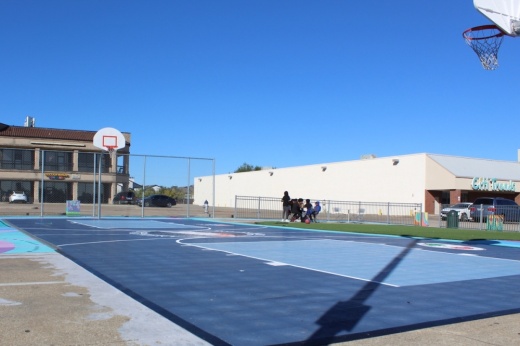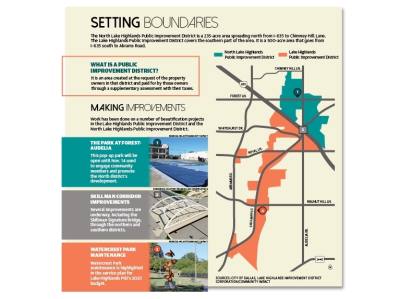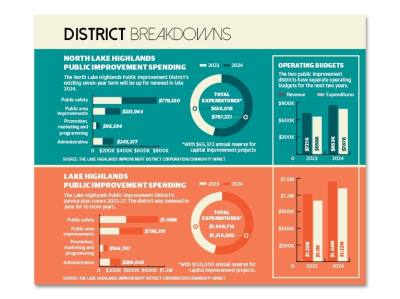A PID, which is a special assessment area created at the request of property owners in that district, aims to improve the quality of life in a geographical area, according to city of Dallas officials.
“[PIDs] have proven track records of bringing value ... by beautifying neighborhoods, planning meaningful events, connecting community members, enhancing public safety and more,” District 10 Council Member Adam McGough said via email.
Managed by the Lake Highlands Improvement District Corporation—a private, nonprofit organization—the Lake Highlands community has two distinct PIDs separated by I-635. The Lake Highlands PID consists of approximately 500 acres, while the North Lake Highlands PID is approximately 235 acres. Officials said the budgets for the PIDs are based on calendar years rather than fiscal years.
Establishing the districts
PIDs are funded by commercial property owners within district boundaries. The assessment amount for the southern district is $0.13 per $100 valuation, according to the service plan. For the north PID, which is still in the early phases of development, the proposed assessment rate for 2023 is $0.12 per $100 valuation.
Annual spending in the district must serve to benefit property owners paying the additional property tax, according to Maria Chagollan, manager with the Dallas Office of Economic Development.
“Those two districts are separate entities with separate budgets, but we look very much from an umbrella perspective,” said Allison Griffin, volunteer board member with the Lake Highlands Improvement District Corporation. “We want–whether it’s our neighbors north of [the Lyndon B. Johnson Freeway] or our neighbors south of LBJ–everybody to be living in a safe and comfortable environment and to be able to be proud that they live in Lake Highlands.”
District officials said they work closely with the Dallas Police Department, property owners, nonprofits, city officials and community members to reduce crime.
“The whole purpose is to be more of a collaborative group and to work to get all the criminal activities out of our district,” LHPID Director Vicky Taylor said. “Those are the different groups that we put together so we can be more productive, and we begin to improve quality of life in our community.”
Public area improvements, or beautification, take up the second largest part of the PID budgets. Those improvements aim to make the districts more attractive, Taylor said.
“It’s more about continuity in our community and creating an environment where we can definitely show the improvements because the things that we do will flow out into the rest of the community,” Taylor said.
Many beautification projects and community engagement projects take place around the districts’ geographical focal point in the Lake Highlands Town Center and have encouraged mixed-use developments to pop up near Watercrest Park. The town center has also served as a location for community engagement events, such as Sundays in the Park and Oktoberfest.
Planning improvements
Created by voters in 2008, the Lake Highlands PID began operating on Jan. 1, 2009, for a seven-year period. It was renewed for another seven years in 2015 when the district began implementing several beautification projects, such as the Skillman Corridor 21st Century Master Plan—a long-range plan to improve streets, landscapes and the median around the Skillman Corridor, according to city documents.
In June, the Lake Highlands PID was renewed for a new 10-year period.
“In previous years, PID entities were created for five- to seven-year terms, but more recently they have been renewed for longer term periods that presumably would allow a management entity to forecast the future needs of the district,” Chagollan said via email.
The Lake Highland’s 2023-27 service plan, which includes street improvements, new art installations, crime reduction programs and youth outreach programs, shows spending for improvements and services will gradually increase each year. Estimated net assessments amount to a total of $8.16 million over the next five years.
Projects in the Lake Highlands PID in addition to the Skillman Signature Bridge, include the Lake Highlands Gateway at Skillman Street and Abrams Road; public art and trails; improvements at the DART trestle on Church Road; and the Thurgood Marshall Loop Trail, according to city documents.
District officials have worked with the city, a landscaping committee and design firm Kimley Horn to construct a master plan for the development, according to Taylor.
Public area improvements outlined in the master plan include Watercrest Park maintenance, street work and median improvement on the entire Skillman corridor. It also includes a new Pegasus sculpture at Church Road and White Rock Trail created by former Lake Highlands High School student Daniel Scroggins.
Work to the north
The North Lake Highlands PID was established in 2017 after developments of the Skillman Corridor and I-635 started to change the landscape of the neighborhood, Griffin said. Community stakeholders, such as private sector developers, nearby property owners and city leaders, wanted to offer resources to areas north of I-635.
“I’m very optimistic and encouraged about what is happening in the north side as well ... but seeing what has happened south of LBJ gives me a lot of optimism about what’s happening and starting to happen,” Griffin said.
District officials said they are focused on reducing crime and enhancing public safety. The PID helped the Dallas Parks & Recreation Department establish a temporary pop-up park called The Park at Forest-Audelia, which has allowed district leaders to show how community engagement and improvement of common areas can reduce crime.
Spending and revenue in the north district will also increase gradually over the next two years and continue to do so beyond 2025, pending successful renewal, per the service plan. The existing term runs until Dec. 1, 2024.
The existing service plan includes projects such as acquiring and installing public art, creating parks and youth recreational sites and educational programming. It also includes aesthetic improvements, such as the Skillman Signature Bridge.
“That’s going to be really exciting, because ... it’ll be visually beautiful, but also adds a stronger connection between the two parts of Lake Highlands,” Griffin said. “We want it to be ... a connection that unifies our whole community and makes it more cohesive.”
Editor's note: This article was updated to correct the title of Allison Griffin, volunteer board member with the Lake Highlands Improvement District Corporation, and to clarify work being done on medians in Lake Highlands. It was also updated to clarify how The Park at Forest-Audelia was established, how public improvement districts are funded, when the Lake Highlands PID began operating and the location of Pegasus sculpture created by former Lake Highlands High School student Daniel Scroggins.







